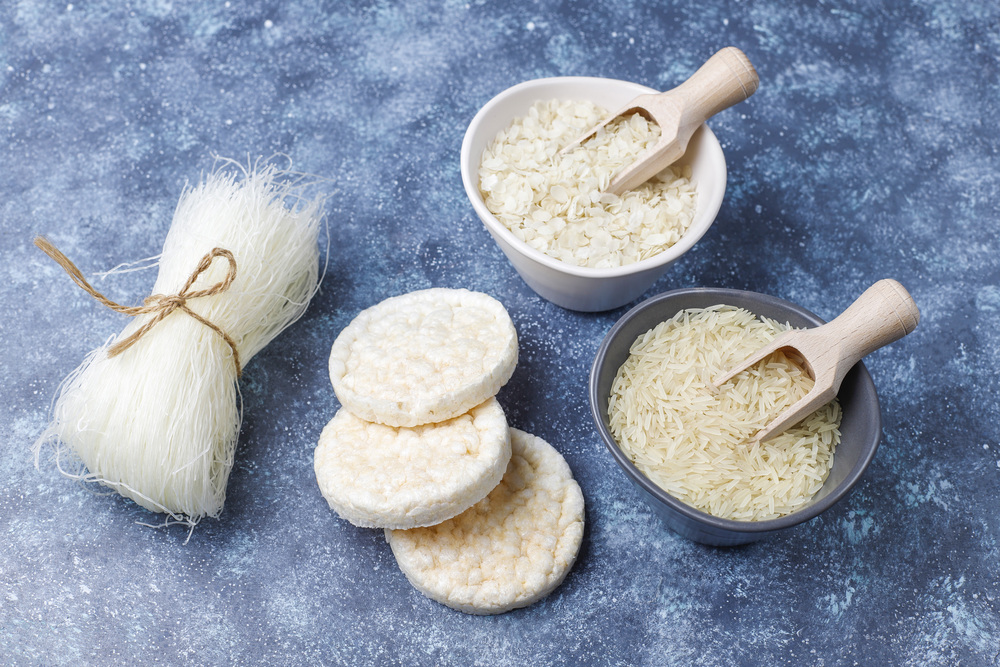What is konjac (Amorphophallus konjac)? Properties, uses, and health effects

Riviera konjac is a plant that stands out from tropical flora, which until recently was mainly cultivated as a curiosity in botanical gardens. Currently, due to its high content of soluble fibre called glucomannan, it is used as a food additive and in the production of dietary supplements. Konjac – what kind of plant is it and what are its most important properties? Who should consider including it in their diet? Is it true that konjac noodles have zero calories and a whole range of health benefits?
Table of contents
- What is konjac? An unusual plant and its ‘corpse flower’
- Konjac – properties and effects of glucomannan
- Where is konjac used?
- Shirataki in the kitchen and diet
- Where to buy konjac noodles?
- Is konjac healthy and gluten-free?
- Konjac noodles (shirataki) – how to prepare and eat them?
- How to store konjac noodles and konjac flour products?
- Glucomannan – side effects and possible contraindications
- Summary – why is konjac gaining popularity around the world?
What is konjac? An unusual plant and its ‘corpse flower’
The konjac plant (Amorphophallus konjac) originates from East Asia. Originally, it was only found in the Chinese province of Yunnan, but it quickly began to be cultivated in Japan and other countries in Southeast Asia. Its flowers resemble lilies, and when in bloom, they emit a very strong smell of carrion, attracting insects – hence the name ‘corpse flower’.
In Far Eastern cuisine, konjac is mainly used to thicken dishes and make noodles, but it is also often eaten raw. The plant is also used in traditional Chinese medicine. Due to its properties, it has a beneficial effect on metabolism and digestion, regulates cholesterol levels and supports the maintenance of normal blood sugar levels.
Konjac – properties and effects of glucomannan
Konjac root is a tuber native to Asia, which owes its properties mainly to a plant fibre called glucomannan. It is a dietary fibre that strongly absorbs water, providing a long-lasting feeling of satiety. In addition, it improves intestinal peristalsis and slows down the absorption of fats and carbohydrates, making it particularly useful for people struggling with overweight and obesity.
What other properties does konjac have? Here are the most important ones:
- supports proper metabolism and digestion
- lowers triglyceride and cholesterol levels in the blood
- supports intestinal function as a prebiotic
- removes harmful toxins from the body
- supports the cardiovascular system
- has a strong alkalising effect, helping to maintain acid-base balance
The properties of glucomannan are valued not only by those looking for ways to improve the functioning of their digestive system. Konjac root can also support weight loss, have a cleansing effect and positively influence cholesterol levels, making it a valuable addition to your daily diet.
Where is konjac used?
Konjac is a raw material that is widely used in the food industry. In Asia, this fibre-rich plant is a common ingredient in various dishes. It is also used in the production of shirataki noodles, which, due to their low calorie content and lack of gluten, can be an interesting alternative for people watching their calorie intake or on a ketogenic diet.
Outside the food industry, the Riviera oddity is also used in cosmetics. Well-known products made using this plant include konjac sponges, which have gentle cleansing, detoxifying and regenerating properties for the skin.
Where is konjac used?
Konjac is a raw material that is widely used in the food industry. In Asia, this fibre-rich plant is a common ingredient in various dishes. It is also used in the production of shirataki noodles, which, due to their low calorie content and lack of gluten, can be an interesting alternative for people who are watching their calorie intake or on a ketogenic diet.
Outside the food industry, the Riviera plant is also used in cosmetics. Well-known products made from this plant include konjac sponges, which have gentle cleansing, detoxifying and skin regenerating properties.
Shirataki in the kitchen and diet
Shirataki noodles are low-carbohydrate products that contain virtually no calories. For this reason, they can be an excellent substitute for traditional pasta or rice, especially for people with type 2 diabetes or those on weight-loss diets. What are konjac noodles made of? They are a product obtained by combining water with the flour of the Amorphophallus konjac plant.
Made from konjac root, this noodle is rich in nutrients and fibre, which regulates bowel function. Due to its considerable elasticity and flexibility, it is ideal as an ingredient in one-pot dishes and soups. It is worth having not only shirataki noodles in your kitchen, but also konjac flour, which is great for thickening sauces, creams, jams and even cakes and ice cream.
Where to buy konjac noodles?
Many people wonder where to buy konjac noodles. Filling and low-calorie products made from this plant can be found mainly in health food shops. If you are looking for high-quality konjac noodles, you can also check out the OstroVit online store. The products offered by this Polish brand are distinguished by their simple composition and are free of unnecessary fillers. This makes them a healthy and filling option that allows you to enjoy the taste of konjac both hot and cold.
Is konjac healthy and gluten-free?
More and more people are choosing to eat konjac noodles. This is because they are filling, healthy and low in calories. They also contain no gluten, sugar or fat, making them ideal for people on weight-loss or plant-based diets. They can also be eaten by people with coeliac disease and gluten intolerance.
Konjac noodles (shirataki) – how to prepare and eat them?
Konjac noodles have a delicate, neutral taste, making them a great ingredient in many dishes. In addition, they provide a longer feeling of satiety, which can be helpful in controlling weight and preventing snacking between meals.
How to prepare and eat them? The process of cooking the noodles is very easy. Just place it in a pot of hot water and wait about 2–3 minutes. Shirtaki prepared this way is a great addition to Chinese stir-fry, pak choi cabbage or Asian stew.
How to store konjac noodles and konjac flour products?
Both noodles and other products made from konjac flour should be stored in a cool, dry place in tightly sealed containers. Once opened, noodles should be stored in water for several days or according to the manufacturer's instructions on the packaging.
Glucomannan – side effects and possible contraindications
Although konjac has many beneficial properties, helping to lower LDL cholesterol and increase the number of beneficial probiotic bacteria, not everyone should consume it. Products based on this plant are not suitable for people who are hypersensitive to glucomannan or have advanced gastrointestinal diseases.
When deciding to supplement your diet with Amorphophallus konjac fibre, remember not to exceed the recommended intake. An excess of this ingredient in the diet can cause adverse side effects. Glucomannan taken in excessive amounts can cause, among other things, flatulence, diarrhoea and abdominal pain. When supplementing, it is recommended to drink an adequate amount of water. If in doubt, it is advisable to consult a doctor.
Summary – why is konjac gaining popularity around the world?
Konjac is a plant with many benefits and versatile uses, which is used in cooking and cosmetics. Although it does not contain digestive enzymes, it is a valuable source of fibre, which supports the intestinal microflora, improves intestinal peristalsis and helps the body absorb nutrients. In addition, konjac lowers total cholesterol, stabilises blood glucose levels and supports metabolism. It is also a valuable source of minerals, including phosphorus, potassium, iron, copper and zinc. Due to its numerous properties, konjac can be a valuable addition to the diet, especially for people who care about their health and figure.

